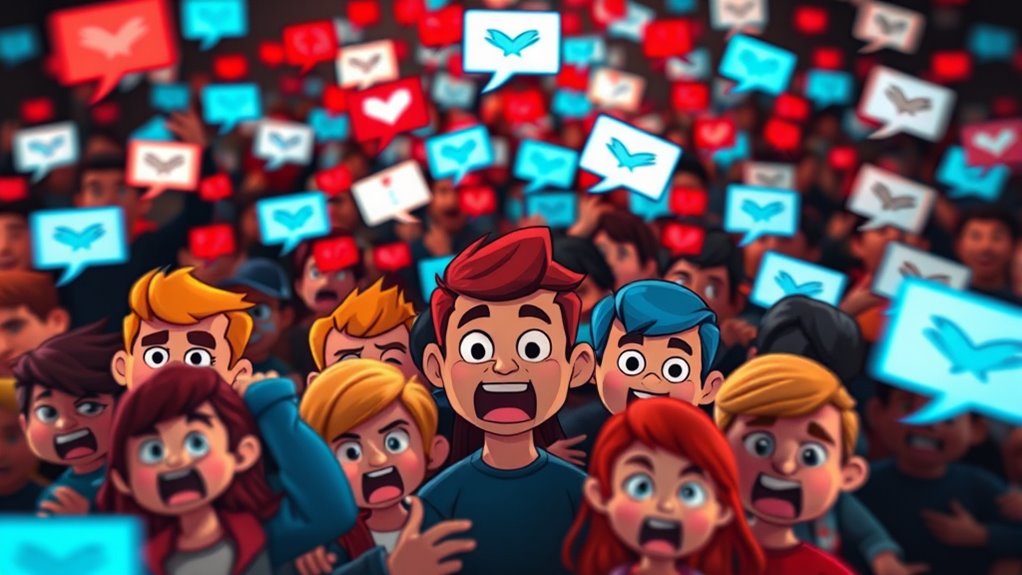Dogpiling involves groups coordinating to attack someone online by bombarding them with comments, reports, and negative messages. This tactic quickly overwhelms the target, making them feel powerless and intimidated. The group’s unified effort amplifies the harassment, often exploiting trending topics to draw in more participants. As you understand these tactics, you’ll see how this relentless pressure manipulates and silences individuals. Continuing further reveals how to recognize and address these harmful behaviors effectively.
Key Takeaways
- Coordinated messaging amplifies harassment, overwhelming targets through rapid-fire comments and mass reporting tactics.
- Exploiting trending topics attracts more participants, increasing the scope and intensity of dogpiling.
- Psychological manipulation aims to erode self-esteem, induce shame, and foster feelings of helplessness in targets.
- Emotional consequences include anxiety, depression, social withdrawal, and distrust in online spaces.
- Recognizing these tactics enables effective risk mitigation and promotes safer online environments.

Dogpiling dynamics happen when a group of people simultaneously target an individual online, often overwhelming them with criticism or harassment. As you observe or become part of these situations, it’s important to understand the tactics analysis involved. Those orchestrating a dogpiling often employ specific strategies to amplify their impact. They might use coordinated messaging, rapid-fire comments, or mass reporting to create an illusion of widespread consensus. Sometimes, they exploit trending topics or controversial statements to draw in more participants. This tactical approach aims to drown out any counterarguments and make the target feel isolated. Recognizing these tactics helps you understand how dogpiling escalates and why it feels so relentless. Implementing risk mitigation tools like reporting and blocking can help protect individuals from prolonged attacks.
The psychological impact of dogpiling on its target can be severe. When you’re the focus of such a coordinated attack, it’s easy to feel overwhelmed and helpless. The barrage of criticism, insults, or false accusations can erode your self-esteem and sense of safety. You might begin questioning your own judgment or feeling anxious about engaging online altogether. The constant negativity can trigger feelings of shame, humiliation, or fear, which only intensifies as the attack continues. This emotional toll is often underestimated, yet it can have lasting effects, including depression or social withdrawal. For some, the psychological impact can be so intense that it affects their mental health long after the attack subsides. Recognizing this emotional toll is vital for anyone involved—whether as a witness, participant, or the target—to understand the gravity of dogpiling.
Additionally, the psychological impact extends beyond just the immediate emotional distress. It influences how you perceive online spaces and interactions. You might become more distrustful, wary of sharing opinions, or hesitant to participate in discussions. The fear of becoming a target can silence voices that might otherwise contribute valuable perspectives. This chilling effect benefits those orchestrating the dogpiling, as it discourages open dialogue and perpetuates a cycle of silence and fear. Recognizing the tactics analysis behind dogpiling reveals that it isn’t just about individual harassment—it’s about controlling the narrative and shaping online discourse through psychological manipulation. The more aware you are of these tactics and their emotional consequences, the better equipped you are to respond or support others who are targeted. Ultimately, understanding the dynamics behind dogpiling can help you navigate online spaces more mindfully and foster a safer digital environment for everyone involved.
Frequently Asked Questions
How Can Victims Effectively Respond to Dogpiling?
You can effectively respond to dogpiling by reaching out to your support network for emotional resilience. Stay calm, avoid engaging with the harassers, and document the abuse. Block or report offenders on social media platforms. Remember, your support network—friends, family, or mental health professionals—can help you process the situation and maintain strength. Focus on self-care and remember that you don’t have to face this alone.
What Psychological Effects Does Dogpiling Have on Targets?
You feel overwhelmed, and that emotional trauma hits hard, often leading to social isolation. Dogpiling targets experience intense anxiety, shame, and helplessness, as the relentless attacks chip away at their self-esteem. This constant barrage erodes trust and isolates you further, making it hard to seek support. The psychological toll is profound, leaving you vulnerable to depression and lasting feelings of shame, even after the harassment stops.
Are There Legal Consequences for Those Participating in Dogpiling?
You should know that participating in dogpiling can have serious legal ramifications. If authorities view your actions as harassment, threats, or cyberbullying, you could face criminal charges depending on your jurisdiction. Laws aim to protect victims, so engaging in coordinated online harassment might lead to fines, community service, or even jail time. Always think twice before joining a dogpiling, as legal consequences are a real risk.
How Does Anonymity Influence the Prevalence of Dogpiling?
Your chances of becoming a target skyrocket when anonymity takes over, making online concealment feel like a superpower. An anonymous participation emboldens people, leading them to act more aggressively because they feel shielded from repercussions. This environment fosters more frequent dogpiling, as individuals hide behind screens, thinking they can’t be identified or held accountable. fundamentally, anonymity fuels the fire, making online harassment more rampant than ever.
What Strategies Can Online Platforms Implement to Prevent Dogpiling?
To prevent dogpiling, online platforms should enhance platform moderation by actively monitoring comments and implementing strict community guidelines. You can also encourage user reporting, making it easy for users to flag abusive behavior. By combining proactive moderation with accessible reporting tools, platforms create a safer environment that discourages coordinated harassment, empowering you to participate more confidently without fear of being overwhelmed or targeted in dogpiling incidents.
Conclusion
You now see how dogpiling can spiral out of control, turning a simple disagreement into a digital witch hunt. It’s like watching a modern-day lynch mob gather, fueled by the chaos of social media. Remember, in this online arena, your voice can either build bridges or burn them down. Stay vigilant and kind, because in this digital age, we’re all just trying to avoid becoming the next victim of a relentless dogpiling frenzy.









